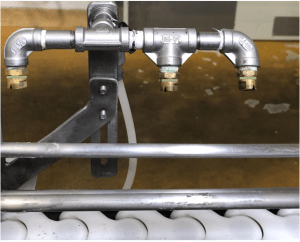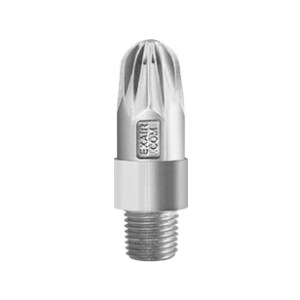
Over the years, EXAIR has come across a variety of different types of blow-off devices. We have seen copper tubes, pipes with a crushed end, fittings with holes drilled into them, and modular flex lines. For compressed air use, these are very dangerous and very inefficient. In many instances, companies will go through a mixed bag of items to make a blow-off device for their application. It is inexpensive to do. But what they do not realized is that these items are very unsafe and will waste your compressed air, costing you much money in the long run.
When EXAIR started to manufacture compressed air products in 1983, we created a culture in making high quality products that are safe, effective, and efficient. Since we stand by our products, we created a program called the Efficiency Lab. We test blow-off devices against EXAIR products in noise levels, flow usage, and force measurements. With calibrated test equipment, we compare the data in a detailed report for the customer to review. If we are less effective, we will state that in the report, but this is very rare. With this quantified information, we can then determine the total amount of air savings and safety improvements that EXAIR products can offer.
With our Efficiency Lab, it is quite simple to do. For starters, you can go to our Product Efficiency Survey on our website to give the conditions for testing. If you wish for a side by side analysis, you can place your pneumatic device in a box and send it to EXAIR. We will run the tests at the specified conditions or in a range of settings. We will then return your pneumatic device back to you with a report of the comparison. This report can be used to show managers, executives, HSE, etc. on the improvements that EXAIR can provide in cost savings and safety.

In a recent Efficiency Lab, a customer sent us a water jet nozzle that he was using to blow off product passing on a conveyor (reference photo above). The customer supplied us with the required information to test. They had three water jet nozzles on a manifold that had ¼” NPT male connections. The air pressure was set at 75 PSIG (5.2 bar), and the air pattern was round. Their annual usage for this blow-off device was 7000 hours continuous, and their electric rate for their facility was $0.10/KWh. The reason that they sent their nozzle to EXAIR was because the operation was very loud, and they believed that they were wasting compressed air. They asked me for a recommendation and what the payback period might be with my selection.

I recommended the model 1101 Super Air Nozzle as our standard round pattern with a ¼” NPT male connection. With our engineered design, the Super Air Nozzle can entrain the “free” ambient air into the air stream to generate a hard-hitting force; using less compressed air. Also, with this suggestion, they will not have to redesign their blow-off station; just remove the water jet nozzles and replace them with the Super Air Nozzles. We tested the water jet nozzle, and we found that it used 17.5 SCFM (496 SLPM) at 75 PSIG (5.2 bar). The noise level was measured at 91.2 dBA for a single nozzle. As a comparison, the model 1101 Super Air Nozzle will only use 13.3 SCFM (376 SLPM) of compressed air at 75 PSIG (5.2 bar); and, the noise level was reduced to 73 dBA for each nozzle.

The first thing that is important to me is safety. High noise levels will cause hearing damage. OSHA generated a standard 29CFR-1910.95a with a chart for Maximum Allowable Noise Exposure. To calculate the noise level for three nozzles, I will reference a previous blog that I wrote: “Measuring and Adding Sounds”. With three water jet nozzles, the total sound is 96 dBA. From the OSHA table above, the usage without hearing protection is less than 4 hours a day. With the Super Air Nozzles, the noise level will be 78 dBA for all three nozzles; well below the requirement for 8 hours of exposure. It is difficult to put a monetary value on safety, but using PPE should never be the first step as a solution.
For the annual savings and the payback period, I will only look at the electrical cost. (Since the Super Air Nozzle is using less compressed air, the maintenance and wear on your air compressor is reduced as well).
The air savings is calculated from the comparison; 17.5 SCFM – 13.3 SCFM = 4.2 SCFM per nozzle. With three nozzles, the total compressed air savings will be 12.6 SCFM for the blow-off station. An air compressor can produce 5.36 SCFM/KW of electricity at a cost of $0.10/KWh. For an annual savings, we have the figures from the information above; 7000 hours/year * 12.6 SCFM * $0.10/KWh * 1KW/5.36 SCFM = $1,645.52/year. For the payback period, the model 1101 Super Air Nozzle has a catalog price of $44.00 each, or $132.00 for three. The customer above did not disclose the cost of the water jet nozzles, but even at a zero value, the payback period will be just under 1 month. Wow!
Not all blow off devices are the same. With the customer above, they were able to reduce their noise levels and compressed air consumption. If your company decides to select an unconventional way to blow off parts without contacting EXAIR, there can be many hidden pitfalls; especially with safety. Besides, if you can save your company thousands of dollars per year as well, why go with a non-standard nozzle? If you have a blow off application and would like to compare it against an EXAIR product, you can discuss the details with an Application Engineer. What do you have to lose?
John Ball
Application Engineer
Email: johnball@exair.com
Twitter: @EXAIR_jb